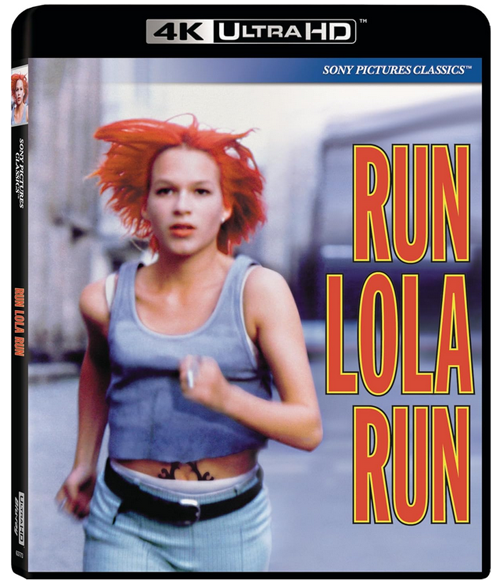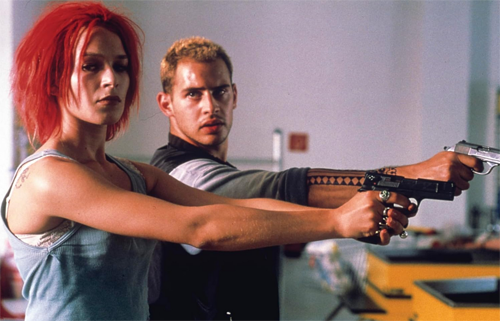
By Todd Garbarini
I
have seen a handful of films that are pure cinema, exhilarating in their
pacing, scoring, and editing. George Miller’s The Road Warrior (1981),
Steven Spielberg’s Raiders of the Lost Ark (1981), and Danny Boyle’s Trainspotting
(1996) are a few examples. Tom Tykwer’s feature film Run Lola Run (1998)
is no less heart-stopping. Its very premise pits itself against the audience
with a high degree of nail-biting scenarios that make us all ponder how we
would react if we found ourselves in a similar plight as our onscreen
protagonists. The film’s overall theme is about fate and chance and the
circumstances that we can find ourselves in when we make one decision over
another despite evaluating multiple alternatives. Filmed in the summer of 1997
and released in New York on Friday, June 18, 1999, this German-lensed high
energy amalgam of images and impulses boasts a premise that is decidedly
simple: small-time hood Manni (Moritz Bleibtreu) has just 20 minutes to return
100,000 Deutsche Marks to his boss Ronnie (Heino Ferch) or risk death.
Unfortunately, while riding the U-Bahn, a tussle with a homeless man causes Manni
to forget the bag of money on the train, leaving him in a horrendous position,
and to the delight of the homeless man. Tearfully begging his girlfriend Lola
(Franke Potente who starred in the Bourne films opposite Matt Damon), a
grey tank-top-sporting twenty-something with firecracker-colored red hair, for
help from a phone booth, they panic and strive to figure out how to keep Manni
alive.
There
are three consecutive scenarios running about 20 minutes each that play out
virtually identically and they all involve the same group of individuals, their
frantic pace barely coming up for air. However, the circumstances that occur are
disparate depending upon how Lola chooses to handle the situation: Lola, on the
run to the phone booth, slams into a woman on the street; an ambulance and a
pane of glass; and an unannounced visit to her father’s office at a bank in a
desperate bid to procure the required cash. At times she is humble, other times
she commandeers a security officer’s pistol and forces her father’s hand for
the cash. The onscreen action is propelled forward by a highly charged and
exceedingly intense techno score by Reinhold Heil, Johnny Klimek and the
director himself, which proves highly effective at conveying Manni and Lola’s
desperation. Irony and happenstance figure in the form of a blind woman, portrayed
by Moritz Bleibtreu’s real-life mother.
The
action stops twice to see flashbacks of the couple in bed following sex, their
images and discussions bathed in red light. Even Lola’s phone is red phone and,
in a nice nod to the jump cut from the bone to the nuclear weapon in Stanley
Kubrick’s 2001: A Space Odyssey (1968), the red phone and green bag of
money are both juxtaposed. It is an exhilarating ride that leaves the audience
breathless.
The original DVD was released on December 21,1999,
and it was followed up with a standard Blu-ray on February 18, 2008, for the
film’s tenth anniversary. The new Sony 4K
UHD Blu-ray looks terrific and ports over the original albeit minimal extras,
while adding a few more that probably appeared on international Blu-rays of the
film:

The
first audio commentary is with the director and the film editor Mathilde
Bonnefoy. This is spoken in German and there are optional English subtitles for
the commentary. They discuss the inspiration and the challenges of making the film,
including keeping track of the footage for the three segments.
The
second audio commentary is with the director and star Potente, and is
thankfully spoken in English with optional English subtitles. It is a fun and
spirited conversation that leaves the audience wanting to hear more.
Making-Of (2008) is a featurette that runs 39:30 and
includes much in the way of behind-the-scenes as the film was being shot in
June 1997. It is spoken in German and has optional English subtitles and
features Tom Tykwer, Maria Kopf, Franke Potente, Moritz Bleibtreu, Frank
Griebe, Stefan Arndt, Alexander Manasse, Mathilde Bonnefoy, Reinhold Heil,
Johnny Klimek, Matthias Lepert, Heino Ferch, Sebastian Schipper, Joachim Krol,
and Nina Petri. There is storyboarding, discussions about what it took to
follow Lola with the camera, juxtaposing 35mm film with color video and black
and white imagery to enunciate different emotions. There is also an amusing
anecdote about Lola’s bright hair color inspiring hairstylists in Germany to
offer the same, which was adopted by many women.
Still
Running (2008) runs (pun intended)
16:58 and primarily features director Tykwer and star Potente in 2007
interviews. He discusses that the film’s genesis is a remake of a short film
that he made called Because which is about an argument that goes in
three different directions. For Lola, this made filming challenging as
even the crew was unable to follow where they were in the script while
shooting. It would have been nice if Because had been included on this
title’s third outing on disc.
Believe runs 4:10 and is a highly visual music video
performed by actress Potente interspersed with the requisite shots from the
film.
Run
Lola Run is a wild ride and is not to
be missed by serious film lovers.
Click here to order from Amazon
